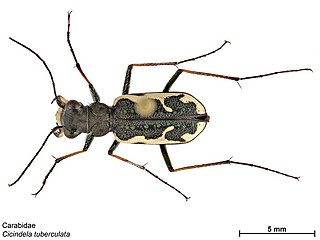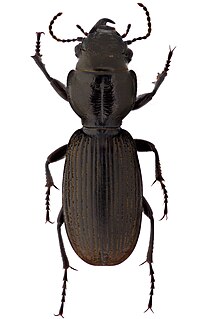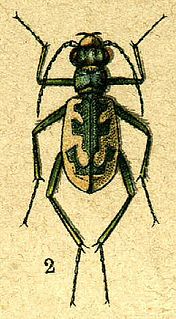
Dermestidae are a family of Coleoptera that are commonly referred to as skin beetles. Other common names include larder beetle, hide or leather beetles, carpet beetles, and khapra beetles. There are approximately 500 to 700 species worldwide. They can range in size from 1 to 12 mm. Key characteristics for adults are round oval shaped bodies covered in scales or setae. The usually clubbed antennae fit into deep grooves. The hind femora also fit into recesses of the coxa. Larvae are scarabaeiform and also have setae.

The steppe polecat, also known as the white or masked polecat, is a species of mustelid native to Central and Eastern Europe and Central Asia. It is listed as Least Concern by the IUCN because of its wide distribution, occurrence in a number of protected areas, and tolerance to some degree of habitat modification. It is generally of a very light yellowish colour, with dark limbs and a dark mask across the face. Compared to its relative, the European polecat, the steppe polecat is larger in size and has a more powerfully built skull.

Phyllophaga is a very large genus of New World scarab beetles in the subfamily Melolonthinae. Common names for this genus and many other related genera in the subfamily Melolonthinae are May beetles, June bugs, and June beetles. They range in size from 12 to 35 mm and are blackish or reddish-brown in colour, without prominent markings, and often rather hairy ventrally. These beetles are nocturnal, coming to lights in great numbers.

Neocicindela tuberculata is a species of tiger beetle in the subfamily Cicindelinae of the family Carabidae, endemic to New Zealand. Its common names include common tiger beetle, moeone, and papapa, and in its laval stage penny doctor, butcher boy, kapuku, kui, kurikuri, moeone, and muremure. Neocicindela tuberculata was the first carabid beetle described from New Zealand. The species can run as fast as 5 miles per hour and are considered to be the fastest running beetles. Adult species prefer clay banks in summer and are good predators when in comes to insects.

Macrodactylus subspinosus is a North American beetle of the family Scarabaeidae. The members of this genus are known as "rose chafers", not to be confused with the European "rose chafer", Cetonia aurata. M. subspinosus occurs from Eastern Canada to Colorado and is considered a pest of many crops and flowers. It is given its common name of rose chafer because it eats the leaves of roses, although it also feeds on many other plants.

Mecodema oconnori is a large-bodied species of ground beetle endemic to the lower half of the North Island, New Zealand. It is mainly found in native forest habitats on the western side of the Tararua and Ruahine Ranges, but is also found in the Manawatu Gorge and some other eastern localities.

Zabrus is a genus of ground beetles. They are, unusually for ground beetles, omnivores or even herbivores, and Zabrus tenebrioides can become a pest in cereal fields.

Abantiades latipennis, known as the Pindi moth, is a species of moth in the family Hepialidae. It may also be referred to as a swift moth or a ghost moth, as this is a common name associated with Hepialidae. Endemic to Australia and identified in 1932, it is most populous in temperate rainforest where eucalypti are prevalent, as the larvae feed primarily on the roots of these trees. Females lay eggs during flight in a scattering fashion. The larvae live for over eighteen months underground, while adult moths survive for approximately one week, as they have no mouthparts with which to feed. The moths are preyed upon by a number of predators, including bats and owls. Brown in colour overall, males are paler and the identifying silver bars of the male's wings are more prominent than those of the female's, with dark margins. Male adults are generally smaller.

The cottonwood borer is a species of longhorn beetle found in the United States east of the Rocky Mountains that feeds on cottonwood trees. It is one of the largest insects in North America, with lengths reaching 40 millimetres (1.6 in) and widths, 12 mm (0.47 in). It is the only species in the genus Plectrodera.

Cephalota elegans is a ground beetle species in the genus Cephalota. European-Siberian steppe species. Body length 12-15 mm. Top copper or bronze-green with a white pattern on elytra. Legs and underparts with a metallic sheen. Head with powerful long jagged mandibles. Beetles and larvae are typical diurnal predators. Beetles fly well and run fast. Larvae live in vertical mink.
Brachinus alexandri is a species of ground beetle from the Brachininae subfamily that can be found in Ukraine, southern part of Russia, Near East, Albania, Armenia, Azerbaijan, Asia Minor, Turkey, Bulgaria, Greece, The species are 9 millimetres (0.35 in) in length, and have black eyes and body, with orange head and legs.
Brachinus efflans is a species of ground beetle in the Brachininae subfamily that can be found in Bulgaria, Germany, Italy, Portugal, Spain, Gibraltar, and on the islands such as Sicily. It can also be found in North African countries such as Algeria, Morocco, Tunisia, and is common in Syria too. The species is black coloured with red head and legs, and is similar to Brachinus crepitans.

Brachinus crepitans is a species of ground beetle in the Brachininae subfamily that can be found in Europe, central Asia, the Middle East, and northern Africa.

Zabrus (Pelor) spinipes is a species of ground beetle belonging to the family Carabidae, genus Zabrus, subgenus Pelor.
Calathus distinguendus is a species of ground beetle from the Platyninae subfamily that can be found in Bulgaria, Greece, Kosovo, Moldova, Montenegro, North Macedonia, Serbia, Voivodina, southern part of Russia and European part of Turkey. It is also found in Georgia, Asia Minor, Caucasus, and Crimea. It have 1 millimetre (0.039 in) long genitalia.

Mormolyce phyllodes, commonly known as the violin beetle, is a species of ground beetles in the subfamily Lebiinae.

Zabrus incrassatus is a species of beetle in the family Carabidae.
Apion apricans is a species of seed weevils native to Europe. It is widespread everywhere. Damages clover and wild. The beetle is 3–3.5 mm in size, black, with a metallic hue, the body is pear-shaped, the legs are partially yellow; rostrum long, almost straight; apex of antennae black, base - red. Egg - 0.3-0.5 mm, yellowish, long, smooth. Larva 2–2.5 mm, white with a creamy hue, curved, dark brown head, on the upper jaws on each side of three growths, the middle of them increased; instead of legs six pairs of small knolls. Pupa 3–3.5 mm, yellowish white.
Bucolus fourneti is a native Australian, small, hairy coccinellid beetle approximately 2.1-4.5 mm in diameter. It was described by Étienne Mulsant in 1850

Habroscelimorpha dorsalis, commonly known as the eastern beach tiger beetle, is a species of flashy tiger beetle in the family Carabidae. It is found in Central America and North America.















